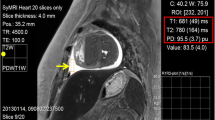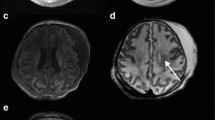Abstract
In a case of a fatal traffic accident, a suspicious finding was identified in the muscular tissue of the left thigh by whole-body postmortem computed tomography. To better interpret the finding, the lower extremities were investigated by magnetic resonance imaging (MRI) and proton magnetic resonance spectroscopy (1H-MRS). MRI revealed the presence of an evenly distributed intramuscular fluid and 1H-MRS of a volume within the fluid detected concentrations of acetate and lactate. The fluid was assumed to be an extravasation of an intraosseous infusion, erroneously administered to the intermediate vastus of the left thigh during resuscitation, which was later confirmed when access to resuscitation protocols was granted. Further ex situ 1H-MRS investigations of five different infusion fluids showed the possible discrimination of the fluids and further indicated the unknown fluid to be a Ringer’s acetate solution. This paper presents the case-based application of postmortem intramuscular 1H-MRS and introduces the possibility of its use to differentiate exo- and endogenic fluids for forensic interpretation. Further research for this method regarding problems in forensic pathology is needed.






Similar content being viewed by others
Abbreviations
- CT:
-
Computed tomography
- MRI:
-
Magnetic resonance imaging
- 1H-MRS:
-
Proton magnetic resonance spectroscopy
- NMR:
-
Nuclear magnetic resonance
- TE:
-
Echo time
- TR:
-
Repetition time
- PPM:
-
Parts per million
- TMA:
-
Trimethylammonium-containing compounds (cholines + carnitine)
- CR3:
-
Methyl group of creatine
- EMCL:
-
Extramyocellular lipids
- IMCL:
-
Intramyocellular lipids
- HES:
-
Hydroxyethyl starch
References
Olds K, Byard RW, Langlois NEI (2015) Injuries associated with resuscitation – an overview. J Forensic Legal Med 33:39–43
Hashimoto Y, Moriya F, Furumiya J (2007) Forensic aspects of complications resulting from cardiopulmonary resuscitation. Legal Med 9(2):94–99
Myburgh JA, Mythen MG (2013) Resuscitation fluids. N Engl J Med 369(13):1243–1251
Gault DT (1993) Extravasation injuries. Br J Plast Surg 46(2):91–96
Shields LB, Hunsaker DM, Hunsaker JC (2003) Iatrogenic catheter-related cardiac tamponade: a case report of fatal hydropericardium following subcutaneous implantation of a chemotherapeutic injection port. J Forensic Sci 48(2):414–418
Booth S, Norton B, Mulvey D (2001) Central venous catheterization and fatal cardiac tamponade. Br J Anaesth 87(2):298–302
Orme RLE, McSwiney M, Chamberlain-Webber R (2007) Fatal cardiac tamponade as a result of a peripherally inserted central venous catheter: a case report and review of the literature. Br J Anaesth 99(3):384–388
dos Santos Modelli ME, Cavalcanti FB (2014) Fatal cardiac tamponade associated with central venous catheter: a report of 2 cases diagnosed in autopsy. Am J Forensic Med Pathol 35(1):26–28
Bartlett CS, DiFelice GS, Buly RL, Quinn TJ, Green DS, Helfet DL (1998) Cardiac arrest as a result of intraabdominal extravasation of fluid during arthroscopic removal of a loose body from the hip joint of a patient with an acetabular fracture. J Orthop Trauma 12(4):294–299
Zech W-D, Jackowski C, Buetikofer Y, Kara L (2014) Characterization and differentiation of body fluids, putrefaction fluid, and blood using Hounsfield unit in postmortem CT. Int J Legal Med 128(5):795–802
Zech W-D, Schwendener N, Persson A, Warntjes MJ, Riva F, Schuster F, Jackowski C (2015) Postmortem quantitative 1.5-T MRI for the differentiation and characterization of serous fluids, blood, CSF, and putrefied CSF. Int J Legal Med 129(5):1127–1136
Ala-Korpela M (2007) Potential role of body fluid 1H NMR metabonomics as a prognostic and diagnostic tool. Expert Rev Mol Diagn 7(6):761–773
Bell JD, Brown JC, Sadler PJ (1989) NMR studies of body fluids. NMR Biomed 2(5–6):246–256
Lindon JC, Nicholson JK, Holmes E, Everett JR (2000) Metabonomics: metabolic processes studied by NMR spectroscopy of biofluids. Concepts in Magnetic Resonance: An Educational Journal 12(5):289–320
Santos ADC, Dutra LM, Menezes LRA, Santos MFC, Barison A (2018) Forensic NMR spectroscopy: just a beginning of a promising partnership. Trends Anal Chem 107:31–42
Tkáč I, Starčuk Z, Choi IY, Gruetter R (1999) In vivo 1H NMR spectroscopy of rat brain at 1 ms echo time. Magn Reson Med 41(4):649–656
Wilson M, Andronesi O, Barker PB, Bartha R, Bizzi A, Bolan PJ, Brindle KM, Choi IY, Cudalbu C, Dydak U (2019) Methodological consensus on clinical proton MRS of the brain: review and recommendations. Magn Reson Med
Klose U (1990) In vivo proton spectroscopy in presence of eddy currents. Magn Reson Med 14(1):26–30
Boesch C (2007) Musculoskeletal spectroscopy. J Magn Reson Imaging 25(2):321–338
Fuchs B, Weishaupt D, Zanetti M, Hodler J, Gerber C (1999) Fatty degeneration of the muscles of the rotator cuff: assessment by computed tomography versus magnetic resonance imaging. J Shoulder Elb Surg 8(6):599–605
Hawley RJ Jr, Schellinger D, O'Doherty DS (1984) Computed tomographic patterns of muscles in neuromuscular diseases. Arch Neurol 41(4):383–387
Cui Q, Lewis IA, Hegeman AD, Anderson ME, Li J, Schulte CF, Westler WM, Eghbalnia HR, Sussman MR, Markley JL (2008) Metabolite identification via the Madison metabolomics consortium database. Nat Biotechnol 26(2):162–164
Lange T, Dydak U, Roberts T, Rowley H, Bjeljac M, Boesiger P (2006) Pitfalls in lactate measurements at 3T. Am J Neuroradiol 27(4):895–901
Simmons CM, Johnson NE, Perkin RM, van Stralen D (1994) Intraosseous extravasation complication reports. Ann Emerg Med 23(2):363–366
Moscati R, Moore GP (1990) Compartment syndrome with resultant amputation following intraosseous infusion. Am J Emerg Med 8(5):470–471
Greenstein YY, Koenig SJ, Mayo PH, Narasimhan M (2016) A serious adult intraosseous catheter complication and review of the literature. Crit Care Med 44(9):e904–e909
Fayad LM, Salibi N, Wang X, Machado AJ, Jacobs MA, Bluemke DA, Barker PB (2010) Quantification of muscle choline concentrations by proton MR spectroscopy at 3 T: technical feasibility. Am J Roentgenol 194(1):W73–W79
Fineschi V, Picchi M, Tassini M, Valensin G, Vivi A (1990) 1H-NMR studies of postmortem biochemical changes in rat skeletal muscle. Forensic Sci Int 44(2–3):225–236
Arús C, Bárány M (1986) Application of high-field 1H-NMR spectroscopy for the study of perifused amphibian and excised mammalian muscles. Biochim Biophys Acta 886(3):411–424
Ntziachristos V, Kreis R, Boesch C, Quistorff B (1997) Dipolar resonance frequency shifts in 1H MR spectra of skeletal muscle: confirmation in rats at 4.7 T in vivo and observation of changes postmortem. Magn Reson Med 38(1):33–39
Asllani I, Shankland E, Pratum T, Kushmerick M (1999) Anisotropic orientation of lactate in skeletal muscle observed by dipolar coupling in 1H NMR spectroscopy. J Magn Reson 139(2):213–224
Boesch C, Machann J, Vermathen P, Schick F (2006) Role of proton MR for the study of muscle lipid metabolism. NMR Biomed 19(7):968–988
Krššák M, Roden M, Mlynárik V, Meyerspeer M, Moser E (2004) 1H NMR relaxation times of skeletal muscle metabolites at 3 T. MAGMA 16(4):155–159. https://doi.org/10.1007/s10334-003-0029-1
Brooks GA (2009) Cell–cell and intracellular lactate shuttles. J Physiol 587(23):5591–5600
Juel C (2001) Current aspects of lactate exchange: lactate/H+ transport in human skeletal muscle. Eur J Appl Physiol 86(1):12–16
Mainwood G, Worsley-Brown P (1975) The effects of extracellular pH and buffer concentration on the efflux of lactate from frog sartorius muscle. J Physiol 250(1):1–22
Roth DA, Brooks GA (1990) Lactate and pyruvate transport is dominated by a pH gradient-sensitive carrier in rat skeletal muscle sarcolemmal vesicles. Arch Biochem Biophys 279(2):386–394
Needham DM (1927) A quantitative study of succinic acid in muscle. II: the metabolic relationships of succinic, malic and fumaric acids. Biochem J 21(3):739
Taegtmeyer H (1978) Metabolic responses to cardiac hypoxia. Increased production of succinate by rabbit papillary muscles. Circ Res 43(5):808–815
Chouchani ET, Pell VR, Gaude E, Aksentijević D, Sundier SY, Robb EL, Logan A, Nadtochiy SM, Ord EN, Smith AC (2014) Ischaemic accumulation of succinate controls reperfusion injury through mitochondrial ROS. Nature 515(7527):431–435
Sacks J, Ganslen RV, Diffee JT (1954) Lactic and pyruvic acid relations in frog muscle. Am J Physiol 177(1):113–114
Sacks J, Morton JH (1956) Lactic and pyruvic acid relations in contracting mammalian muscle. Am J Physiol 186(2):221–223
Solonen KA, Tarkkanen L, Närvänen S, Gordin R (1968) Metabolic changes in the upper limb during tourniquet ischaemia: a clinical study. Acta Orthop Scand 39(1–3):20–32
Markenstein L, Appelt-Menzel A, Metzger M, Wenz G (2014) Conjugates of methylated cyclodextrin derivatives and hydroxyethyl starch (HES): synthesis, cytotoxicity and inclusion of anaesthetic actives. Beilstein J Org Chem 10:3087–3096
Acknowledgments
The authors express their gratitude to Emma Louise Kessler, MD for her generous donation to the Zurich Institute of Forensic Medicine, University of Zurich, Switzerland.
Author information
Authors and Affiliations
Corresponding author
Ethics declarations
This article does not contain any studies with (living) human participants or animals performed by any of the authors. No informed consent was required. Ethical approval was obtained by the Ethics Committee of the Canton of Zurich, Nr. KEK ZH-Nr. 15–0686 and 18–0758.
Conflict of interest
The authors declare that they have no conflict of interest.
Additional information
Publisher’s note
Springer Nature remains neutral with regard to jurisdictional claims in published maps and institutional affiliations.
Rights and permissions
About this article
Cite this article
Heimer, J., Gascho, D., Tappero, C. et al. Noninvasive analysis and identification of an intramuscular fluid collection by postmortem 1H-MRS in a case of a fatal motor vehicle accident. Int J Legal Med 134, 1167–1174 (2020). https://doi.org/10.1007/s00414-019-02190-2
Received:
Accepted:
Published:
Issue Date:
DOI: https://doi.org/10.1007/s00414-019-02190-2




